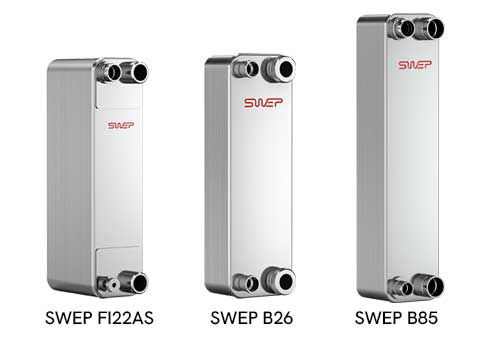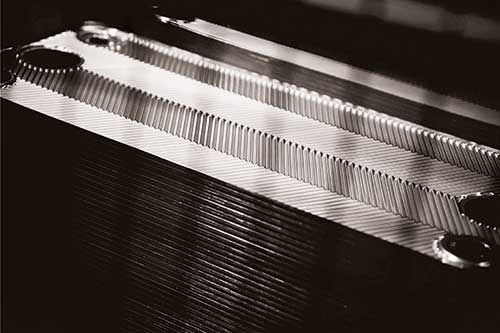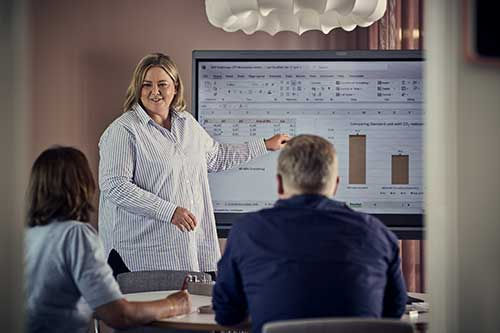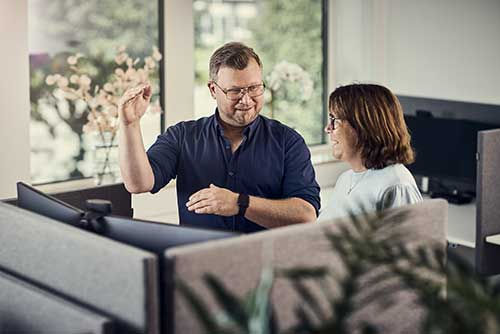CO2-reduced steel BPHEs
Look forward to a sustainable difference
Cut scope 3 emissions without compromise
No need to change your system setup or design – just achieve a smaller carbon footprint with one simple choice. SWEP BPHEs made from CO2 -reduced steel are technically the same as our conventional units, except for one small detail: the stainless steel is produced with sustainable methods, which makes a world of difference in value chain emissions. Available first to HVAC customers in Europe, our range will eventually expand to meet the future needs of more applications and markets. Because every gram really does count globally.

Maximum efficiency, minimum emissions
SWEP FI22AS, SWEP B26 and SWEP B85 cover capacities up to 50 kW and use natural refrigerants. Now, with the option of channel plates made from CO2 -reduced steel, these high-performance brazed plate heat exchangers offer yet another opportunity to make less of an environmental impact. This switch to even more sustainable solutions allows you to proactively lower emissions, stay ahead of stricter regulations and avoid rising carbon costs and tariffs.
Up to 50% lower embedded emissions
A SWEP brazed plate heat exchanger with CO2-reduced steel lower carbon dioxide emissions by up to 50% compared to the same unit based on conventional steel. The calculations are based on actual SWEP products within the current range of CO 2 -reduced steel units. The percentage varies, depending on the specific unit type and number of channel plates – the larger the unit, the greater the reduction. Our team of experts working on material composition, BPHE configurations, and environmental calculations has developed a broad application basis for the accurate carbon footprint declarations that we will provide for each unit delivered.

Sustainability
Commitment
Let’s take sustainability further
From the start, SWEP has been on a quest to create more from less. We work hard to reduce the company's impact on the environment at all five of our manufacturing plants around the world. Our Swedish plant in Landskrona converted to renewable energy more than fifteen years ago and recycles 100% of production scrap. Now, the plant is our first to manufacture brazed plate heat exchangers with steel that is produced in a sustainable way. Because materials still dominate BPHE lifecycle emissions, introducing CO2-reduced steel is a natural step in our sustainability journey. And now, yours. Together, we enable the global shift to electrification and phase-out of fossil fuels to tackle climate change, while improving quality of life for more people.
Building on strengths, advancing industries
Strong, resilient and durable – stainless steel has always been the obvious material, along with copper, for our brazed plate heat exchangers. The steel industry has made great advances in supply chains and production processes over the last decade, but only recently have stainless steel coils based on renewable energy sources, improved water management, optimized processes and high-quality recycled rawmaterial become available. The result? The exact same technical properties, but a 93%* lower carbon footprint than the global industry average.
*) Reference: Circle Green | Outokumpu
All the performance, with a certified edge
To the naked eye, SWEP CO2-reduced steel BPHEs are identical to the conventional units you already rely on. They offer the same thermal, hydraulic and mechanical performance, and integrate seamlessly into your system, requiring no process changes or prototype testing. The only real difference is their carbon footprint. Each SWEP CO2-reduced steel BPHE comes with a carbon footprint declaration linked to its serial number, in accordance with ISO 14067. This ensures consistency and credibility for your cradle-to-gate reporting.

Comply and minimize carbonwise
With expanding regulations such as ESPR, CBAM and DPP, conducting life cycle analyses of your products is acute business acumen. The documentation provided with SWEP CO2-reduced steel BPHE gives you a complete account of its carbon footprint with full transparency and traceability. This, in turn, is a vital tool for calculating your product’s carbon footprint. Choosing this option also means proactively minimizing unnecessary costs, such as rising carbon taxes and avoiding tariffs on imported goods. If you need support or have questions about sustainable design, please feel free to contact us.
Enhance sales
Verified sustainable solutions are increasingly required in public procurements. They are also a selling point with both businesses and consumers willing to pay more for greener alternatives***. As a way to access subsidies and tax breaks, they also strengthen your competitiveness. With our CO2-reduction data and certifications, you can calculate your end-product’s overall carbon footprint and enhance your brand, market position and sustainability communication with concrete facts.
*** The Climate Group, Ramboll and PwC 2024 Voice of the Consumer.

The difference starts here
Led by Senior Material Engineer Anne Grönlund our team of application, R&D, sales and sustainability experts is ready to align your performance goals and address questions you may not have anticipated. From your desired effect, we present the optimal brazed plate heat exchanger and give you a complete overview, ensuring an informed and smooth transition into a carbon-reduced future. Let’s talk!



